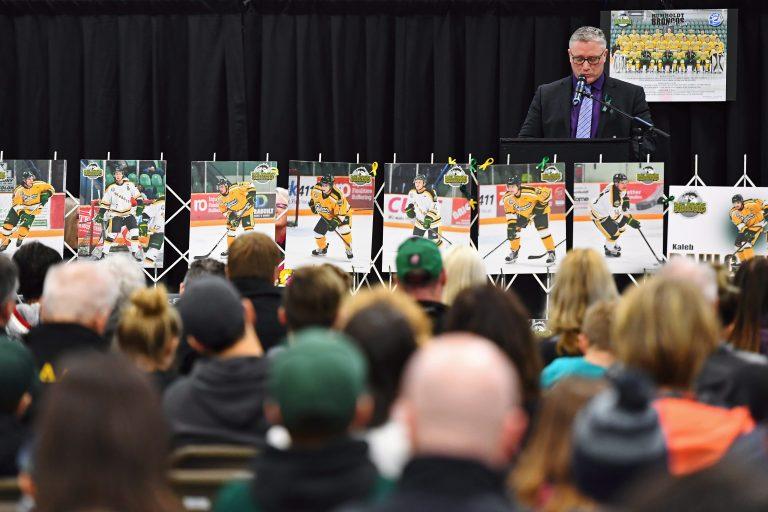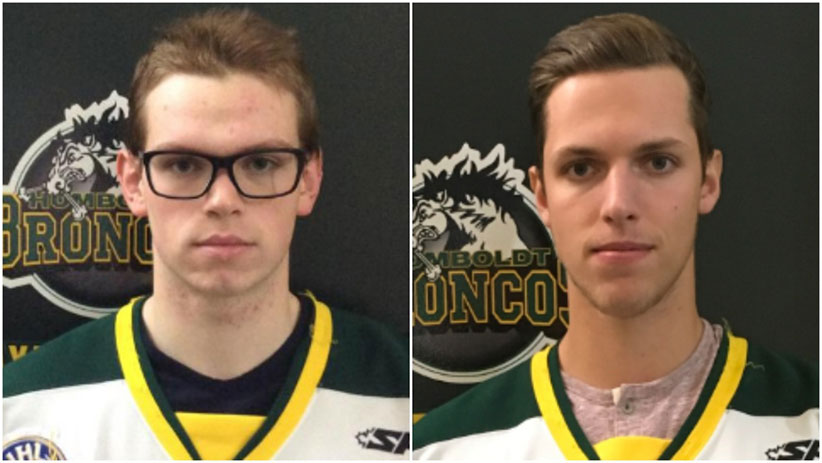What we know about the misidentification of Humboldt players Parker Tobin and Xavier Labelle
The mix-up has brought a blizzard of emotion for not only the biological parents, but also the billet parents who hosted each boy

Kevin Garinger, President of the Humboldt Broncos, speaks during a vigil at the Elgar Petersen Arena, home of the Humboldt Broncos, to honour the victims of a fatal bus accident in Humboldt, Sask. on Sunday, April 8, 2018. (Jonathan Hayward/CP)
Share
Just two months separated the ages of Humboldt Broncos defenceman Xavier Labelle and goalie Parker Tobin. Both players had athletic builds, though one was two inches taller and five pounds heavier. And the two 18-year-olds had dyed yellow hair, as all teammates did for the Junior A league playoffs.
Friday’s team bus crash created one grim distinction: one Bronco teammate died, while the other is recovering from severe injuries in hospital. Yet, for nearly two days, medical authorities had wrongly told families tell which young men was which.
Saskatchewan’s medical examiner found out Sunday night, and announced publicly Monday morning, that Parker Tobin was dead and Xavier Labelle was injured. Authorities had initially concluded that the opposite was true. The Tobin and Labelle families were in Saskatoon this weekend at the hospital and makeshift morgue, respectively, apparently unable to realize immediately that they’d been standing over a boy that wasn’t theirs.
After the error had been realized, Labelle’s brother, Isaac Labelle, posted on Facebook: “All I can say is miracles do exist. My deepest condolences to the Tobin family.”
Government spokesman Drew Wilby apologized on behalf of the province and coroner’s office for the mixup. “I can’t even imagine putting myself in those families’ shoes, to first getting notice that your loved ones were in a collision of this nature, and then to find out who they thought was their loved one wasn’t potentially actually their loved one,” he told reporters Monday.
Wilby shed little light on how the rare mistake was made, as the coroner’s office was dealing with a tragedy of a scale unprecedented in recent Saskatchewan history, with 15 dead and 14 others injured. He noted that staff were challenged by the fact the young players had similar hair colour and builds. There wasn’t time to secure dental records—the usual gold standard for positive identification—and the families needed to know without having to wait days to scour dental offices across Western Canada for documents. So staff relied on information from various agencies and “community resources” to make their determination. We “believed that positive identification had been done appropriately,” said Wilby, who speaks for Saskatchewan’s justice ministry. All families that were told a member had died were in Saskatoon and helped with the identification process Saturday, he added.
On Sunday night, something raised questions for the professionals, and they were able to determine the hospitalized teen they thought was Tobin was actually Labelle, and they realized Tobin was, in fact, deceased.

Hockey broadcaster Ron MacLean, along with colleague Don Cherry, were in a Saskatoon hospital room on Sunday afternoon with Tobin’s parents and brother and the boy they believed was Parker. “I can remember the mom saying, ‘he’s beginning to look more like our boy.’ Can you imagine?” MacLean recalled Monday on a Rogers radio broadcast. “I even stood over the body and was sort of talking to the child, saying it’s Ron and Don, we want to do a coaches’ corner bedside for you tonight, everything’s going to be OK. And when I was saying that, the boy began to rise up a little bit and the nurse quickly put him back down, because this boy, we now know, was Xavier Labelle.”
In a joint statement, the Tobin and Labelle families said they are “grieving together,” and their focus will not be on “the confusion in an unimaginable tragedy.”
The news brings an intense blizzard of emotion for not only the biological parents, but also the billet parents who hosted Labelle from Saskatoon and the bespectacled Tobin from Stony Plain, a small city just west of Edmonton. Tobin’s hosts in Humboldt had two Broncos—the other, Tyler Smith, is recovering—while Rene and Devin Cannon had understood that all three of their billets had passed away: Labelle, Adam Herold and Logan Hunter.
“We know that our ray of light is someone else’s shattering darkness,” Rene tweeted on Monday. “Our hearts are still broken at the loss of two of our boys and for the other family and billet family involved. We are grateful for the gift of being able to say all the words we thought we’d never say.”
We know that our ray of light is someone else’s shattering darkness.
Our hearts are still broken at the loss of 2 of our boys and for the other family and billet family involved. We are grateful for the gift of being able to say all the words we thought we’d never say. pic.twitter.com/GNH8Pil3kZ— Rene Cannon (@renecannon) April 9, 2018
While rare, there are other cases of coroners misidentifying the dead. In Southern Alberta in 2005, two young women were among six teens involved in a small car rollover. Judy Medicine Crane was told by Blood Tribe Police that her 17-year-old daughter Misty had died, while friend Chantal Many Greyhorses was in critical condition at a Calgary hospital—identification based in part on witness accounts, according to a Calgary Herald story.
Medicine Crane made funeral arrangements, and was warned her daughter’s disfigurement was so severe the mom shouldn’t view the body. She realized something was amiss when the jewellery bag the funeral director gave her contained a silver tongue ring, not Judy’s silver piercing. Then the funeral director checked for the tattoo the mother had described—it wasn’t there. Judy was actually the one in the Calgary hospital, severely brain damaged, and Medicine Crane had time to visit her loved one before hospital staff removed the tubes and machines.
Last year in California, Frank Kerrigan had buried the person he thought was his 57-year-old son Frankie, a homeless and mentally ill man. The Orange County coroner’s office maintained they had identified him using his fingerprints, and told the elder Kerrigan it wasn’t necessary to come down and identify the body. Eleven days after the family held the funeral, a long-time family friend put the grieving father on the phone with his still-alive son.
The Kerrigan family has sued the coroner’s office for negligence.